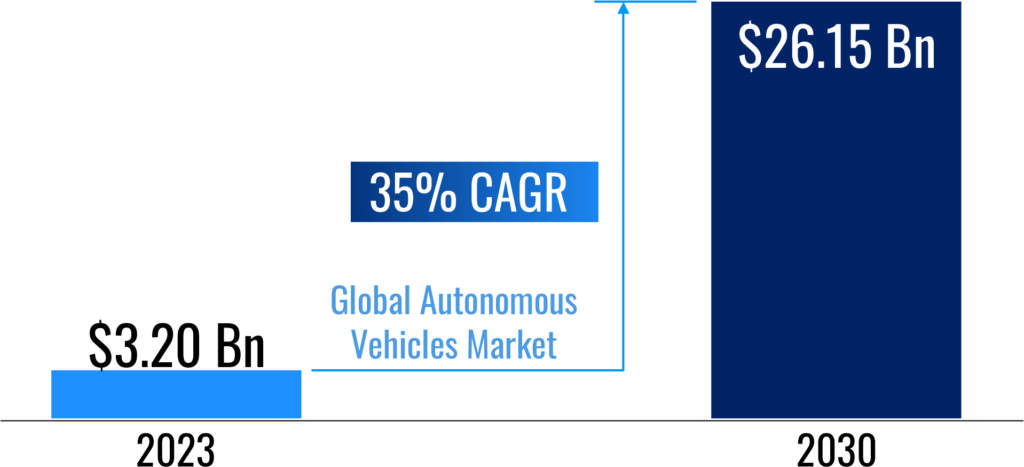In this dynamic technology landscape where progress unfolds at an outstanding rate, the evolution of transportation has undergone amazing transformations. From the days of horse-drawn carriages to the introduction of motorized vehicles, transportation has continuously embraced innovation. Today, this journey reaches new heights with the emergence of autonomous vehicles (AVs).
Today, cars equipped with advanced sensors, machine learning algorithms and artificial intelligence are capable of driving themselves. These autonomous vehicles utilize technologies such as radar, lidar, GPS, and computer vision to perceive and respond to their environment in real-time, navigating roads without human intervention.
The potential advantages of AVs are significant. They claim to eliminate traffic accidents due to human mistakes, relieve congestion, and provide transportation options for those who are unable to drive. Furthermore, AVs are expected to improve urban planning efficiency and sustainability.
However, reaching widespread use presents problems such as legal barriers, ethical concerns, and the necessity for considerable technology and infrastructure breakthroughs. Despite these challenges, the development of self-driving vehicles continues to fuel innovation, signaling a paradigm shift in the future of transportation.
Enhanced Safety and Reduced Accidents
One of the most compelling promises of autonomous vehicles is their potential to significantly improve road safety. Human error, which accounts for the majority of traffic accidents worldwide, could be greatly mitigated with AVs. These vehicles are equipped with advanced sensors, cameras, and artificial intelligence (AI) algorithms that enable them to perceive their surroundings in real-time and make split-second decisions. By eliminating factors like distracted driving, fatigue, and human error, AVs have the potential to make our roads safer for everyone.
Accessibility and Mobility for All
Beyond safety, autonomous vehicles hold the key to enhancing mobility for segments of the population traditionally underserved by conventional transportation options. Elderly individuals, people with disabilities, and those who cannot drive due to medical reasons could gain newfound independence and freedom with AVs. Imagine a world where getting to appointments, running errands, or simply visiting friends and family becomes effortless and accessible to all.
Each year Signicent provides consultancy to hundreds of organizations to help transform their innovations to value.
Environmental Benefits and Efficiency
The environmental impact of autonomous vehicles is another compelling reason to embrace this technology. AVs can optimize driving patterns, reduce traffic congestion, and improve fuel efficiency through smoother acceleration and braking. Moreover, as electric and hybrid AVs become more prevalent, they promise to further reduce greenhouse gas emissions and lessen our reliance on fossil fuels. This shift towards cleaner transportation is crucial in combating climate change and creating sustainable cities of the future.
At Signicent, we specialize in providing comprehensive Technology Assessment & Valuation that empowers businesses to make informed decisions. Our expert team analyzes the latest technological trends, evaluates market potential, and identifies opportunities for innovation.
Economic and Productivity Gains
From an economic standpoint, AVs have the potential to generate significant cost savings and productivity gains. Businesses reliant on transportation, such as logistics and delivery services, can benefit from reduced labor costs, optimized routes, and improved fleet management. Commuters can reclaim valuable time spent behind the wheel, using it for work, relaxation, or catching up on tasks. This increased productivity could have ripple effects across various industries, contributing to economic growth and innovation.
Challenges and Considerations
While the promise of autonomous vehicles is immense, there are challenges and considerations that must be addressed for widespread adoption. Regulatory frameworks, infrastructure development, cybersecurity concerns, and public acceptance are all critical factors that need careful consideration. Policymakers, industry leaders, and communities must work together to navigate these challenges and ensure the safe and responsible integration of AVs into our transportation systems.
Looking Ahead
As research and development in autonomous vehicles continue to advance, the future looks promising. Innovations in AI, sensor technology, and vehicle-to-vehicle communication are paving the way for safer, more efficient transportation solutions. From urban mobility to long-haul logistics, AVs are set to redefine how we move goods and people, offering a glimpse into a future where transportation is not only smarter but also more sustainable and inclusive.
Market research:
As per Signicent’s Market Researchers, the global market for Autonomous vehicles is likely to reach values in the ranges shown below.

Key players:
According to Signicent’s Market Intelligence, the autonomous vehicle industry is booming, and the following companies and startups are shaping the future of mobility:
Leading Players:

Startups:
In conclusion, autonomous vehicles represent a paradigm shift in transportation that holds immense potential to improve safety, accessibility, and environmental sustainability. While challenges remain, the benefits of AVs far outweigh the hurdles, offering a glimpse into a future where mobility is safer, more efficient, and more equitable for all. As we continue on this journey towards autonomous driving, the possibilities are endless, and the road ahead is full of promise.
About Signicent LLP
We assist businesses globally in their technology innovations, R&D, new product development, patents, valuation, product commercialization & market research needs.
Services Offered:
- Technology Intelligence
- Market Research
- Patent Landscape
- Technology gap analysis
- Design Patent Search
- Portfolio Analysis
- Freedom to operate
- Bio Sequence Search
- Innovation pipeline identification
- Chemical Structure Search
- Patent Invalidity Search
- Manufacturers Search/ Supplier search
- Patent Licensing Services
Elevate your Innovation and Research with Signicent’s cutting edge approach to assist you with Technology and Market related matters alongside the IP aspect of the analysis.


